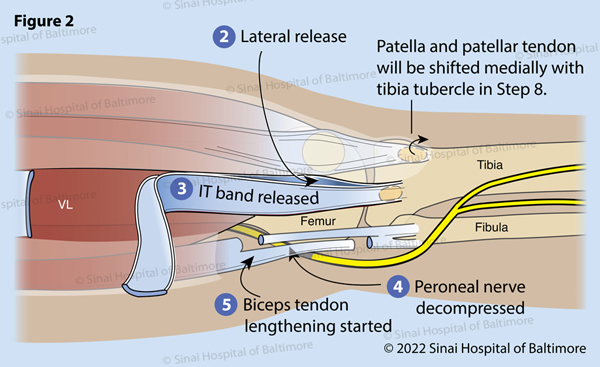Congenital Dislocation of the Patella
What is congenital dislocation of the patella?
Congenital dislocation of the patella is a rare condition where the kneecap (or patella) is out of place at the knee joint. This is usually discovered at birth or uncovered later when a child has difficulty walking and has an abnormal gait. The patella is positioned on the outside of the knee instead of in front of the knee. Congenital refers to children being born with this condition; it is different than adolescents or older children who may have episodes where their kneecap moves out of place with sports or activities because of laxity (looseness) or injury. Congenital dislocation of the patella may be seen in association with other lower leg and/or foot deformities. Sometimes the knee is stuck in a bent position, called a flexion contracture. Congenital dislocation of the patella may also be associated with Down syndrome, nail patella syndrome, Larsen syndrome, Rubinstein-Taybi syndrome, arthrogryposis, Ellis-van Creveld syndrome, diastrophic dysplasia as well as many other conditions.
What problems occur with congenital dislocation of the patella?
A wide spectrum of problems occur along with congenital patellar dislocation, with the most severe including rotational dislocations of the tibia (shin bone) on the femur (thigh bone). A primary contributor to congenital dislocation of the patella is a tight iliotibial (IT) band, which is a dense tissue connection from the lateral aspect of the pelvis to the lateral top of the tibia along the thigh. The IT band often can be felt when the leg is pulled across the midline in the extended position; the tightness of the IT band can lead to rotational dislocation of the knee in many cases.
The child may be delayed in walking, present with a knock-knee appearance, or other lower extremity deformity (external tibial torsion). In some cases, children lose the ability to walk as they get older, because the strategies they were using to compensate can no longer accommodate their increasing body mass. The kneecap may be small and can be felt or seen over the outer aspect of the knee. In many cases, it cannot be detected on physical examination, and a strict attention to detail is needed to diagnose the condition. The groove or area where the patella travels up and down over the front of the knee with motion is called the trochlea. The trochlea may be shallow or underdeveloped; this is called trochlear dysplasia.
Special imaging such as an MRI or ultrasound may be necessary to identify the patella and its location about the knee and for possible planning for intervention. Children with congenitally-dislocated patellas are generally unable to actively straighten the leg against gravity, as the mechanical integrity of the extensor mechanism is compromised.
How is congenital dislocation of the patella treated?
Surgical treatment is generally needed for congenital dislocation of the patella. Realignment of all components of the deformity is required to minimize risk of recurrence. This may consist of lengthening the tissues and muscles on the top and outside of the thigh. The IT band must be lengthened, and it may be used as a new ligament to maintain reduction of the dislocated knee. The peroneal nerve must be protected and decompressed to avoid damage when the knee straightens. Surgical treatment may also involve shortening and straightening the thigh bone (femoral osteotomy) in order to protect the nerves and blood vessels behind the knee. The insertion of the patellar tendon often needs to be reoriented, in addition to adjusting the orientation of other muscles within the thigh. Improvement may be seen in knock knees and external tibial torsion, as well as in knee extension, standing position and walking tolerance. Successful treatment restores a more normal mechanical alignment, and, in turn, better walking, mobility and function.
Why choose the International Center for Limb Lengthening for treatment of congenital dislocation of the patella?
Congenital dislocation of the patella is a very complex problem with few centers around the world that have significant experience with its treatment. The myriad of anatomical problems require individual treatment and consideration; surgical experience with the condition is paramount.
Limb Lengthening and deformity correction are complex processes. Your doctor at the International Center for Limb Lengthening will take the time to make sure you understand all your options and then will customize your treatment to meet your specific needs. Our patients benefit from our team-centered approach with world-renowned surgeons and specialized physician assistants, nurses and physical therapists. We help patients with congenital dislocation of the patella achieve their best possible result.



